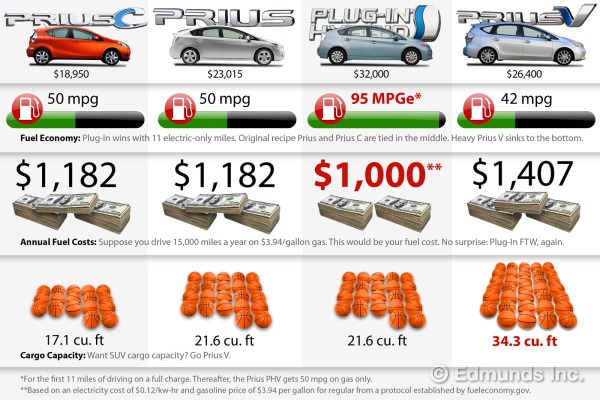
These days, there are more than 50 hybrids currently on the market, so green-minded consumers face no shortage of choices. There are hybrids in almost every segment. You can get hybrid family sedans, hybrid crossovers and hybrid luxury cars.
Against this evolving landscape, one thing has remained the same: Year after year, the Toyota Prius has been the best-selling hybrid in the land, by a wide margin. Extreme fuel efficiency, spacious utility and Toyota reliability have been cornerstones of the Prius' enduring success.
It's little wonder that Toyota has chosen to build on the car's popularity by expanding the range of Prius models. The original Prius midsize hatchback has been joined by a subcompact hatchback (the Prius C), a larger wagon (the Prius V) and a plug-in hybrid that can travel up to 11 miles solely on electric power. Just as with the hybrid segment in general, there are now different Prius models to suit the needs of a wide variety of car shoppers.
Sorting Through the Choices
Singles seeking frugal solutions will want to check out the Toyota Prius C. At 50 mpg combined, it's just as fuel-efficient as the original Prius, but with a starting price that's $5,000 cheaper, it's easier on the wallet. Relative to the original Prius, the C is 19 inches shorter overall, 2 inches shorter in height and width, and 500 pounds lighter. As subcompacts go, the C offers decent passenger room, and its 17.1 cubic feet of cargo capacity is on par with that of other hatchbacks in this class. Its lighter weight helps give the C a livelier driving experience than you'll find in its siblings.
The original Prius remains a great pick for families or singles who appreciate fuel efficiency and utility. Though no match for the Prius C when it comes to driver engagement, this larger Prius is a lot more versatile, with loads of cargo capacity (21.6 cubic feet) and ample rear-seat legroom. A wealth of luxury-oriented tech features is available, and all models come with Bluetooth phone and audio connectivity, dedicated iPod controls and a touchscreen electronics interface. Toyota's new Entune system is offered, and bundles real-time satellite information with a suite of apps that connect the Prius to the Internet via your smartphone. Collision avoidance technology also is available, including a pre-collision alert system and a lane-departure warning system. Like the Toyota Prius C, it's rated at 50 mpg combined.
If you like the Prius but need more cargo room, look no further than the Toyota Prius V. Six inches longer and 3 inches taller than the original Prius, this wagon offers 60 percent more cargo capacity, with a robust 34.3 cubic feet of luggage space behind the rear seats. At 42 mpg combined, the V is the least frugal member of the Prius family. However, its mileage is still good enough to make it more fuel-efficient than its rivals by a wide margin.
Finally, if you like the idea of reducing fuel costs with at-home plug-in capability, there's the Toyota Prius Plug-In. Its dimensions mirror those of the original Prius, but thanks to its expanded electric-only range, the Plug-In is good for 95 MPGe (miles per gallon equivalent) for the first 11 miles of driving on a full charge. After that, it gets 50 mpg on gasoline only. Keep in mind, though, that with a starting price of $32,000, this is the most expensive Prius in the lineup.
With gas prices on the rise, these models make a lot of sense. If fuel efficiency is high on your list of priorities, there's likely a pick in the Toyota Prius family that's right for you.
For Further Information
Compare Toyota Prius Specs Side-by-Side
2012 Toyota Prius Hatchback
2012 Toyota Prius C
2012 Toyota Prius Plug-In
2012 Toyota Prius V